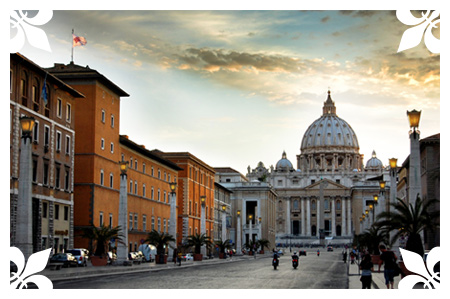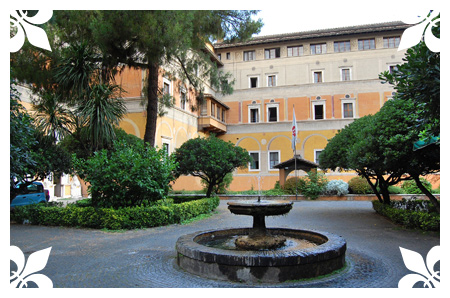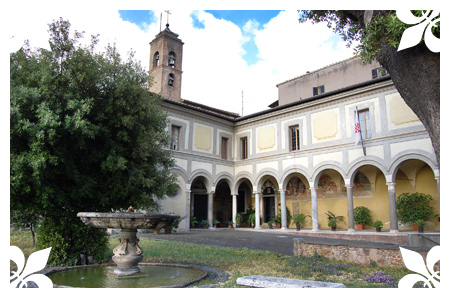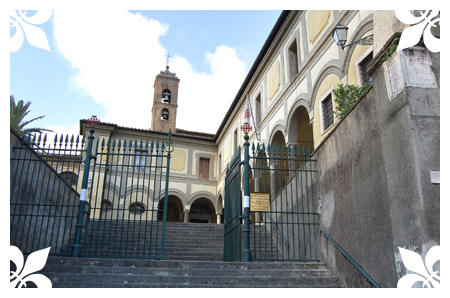|
Visit our website
www.oessh.va
THE ORDER’S HEADQUARTERS


THE DOMENICO DELLA ROVERE PALACE
(Official reception rooms of the Order)
Today, this "palace" is often incorrectly called the "Palazzo dei Penitenzieri", after the name of the previous owners, the Penitentiary Fathers of St. Peter's. In the 15th century, however, it was the residence of Domenico della Rovere, a Cardinal from the Piedmont, who belonged to the inner circle surrounding Pope Sixtus IV della Rovere. Domenico della Rovere had a brilliant career in Rome, making his name in a number of important and highly remunerated ecclesiastical posts. The palazzo was built in the late 15th century, between 1480 and 1490; the Florentine architect, Baccio Pontelli, modelled it closely on the architectural style of Palazzo Venezia, the most important building in 15th century Rome. In fact, in the 15th century, the Palazzo della Rovere was so greatly praised and admired that Emperor Charles VIII chose to stay here when he visited Rome in 1495. The five halls of the piano nobile, are now the official reception rooms of the Equestrian Order of the Holy Sepulchre of Jerusalem and one of them is home to an extremely important ceiling by the artist Pinturicchio and his atelier. The Hall of the Grand Master is lavishly decorated with trompe l'œil architectural features depicting a terrace looking out onto a landscape. The Hall of the Seasons retains fragments of a very rare kind of portrayal of the months of the year, each month represented by the myth that gave rise to its zodiacal sign; the scenes which have been best preserved relate to June, with a peasant making hay and the myth of Hercules and the Hydra – the origin of the sign of Cancer; October, with the bird-catcher of Byzantine legend and the myth of Orion – the origin of the sign, Scorpio; and March, with soldiers ready to set off to war. The next hall has fine lunettes enclosing images of the prophets delivering their words of wisdom and apostles accompanied by verses from the Creed; the frieze around the exquisite gold and blue ceiling features portraits of Roman Emperors. The most sumptuous and best preserved ceiling is in the Hall of the Demigods. This astonishing composition of 63 panels painted on board and enclosed in wooden caissons is full of creatures from mediaeval bestiaries flanked by allegorical and symbolic images drawn from classical tombs – very important evidence indeed of a culture at the crossroads between the Middle Ages and the Renaissance. Fantastic animals and monsters, mythological gods and goddesses, chimaeras (creatures half-human, half-beast) such as sirens, tritons, centaurs, satyrs and sphinxes stand out against the gilded background of the caissons; some are playing musical instruments or fighting with rudimentary weapons in a huge variety of poses.
In the left wing of the palazzo – currently occupied by the Hotel Columbus – the old refectory overlooking the hanging garden still has the ancient 15th century décor of themes based on nature, as well as allegorical figures clearly influenced by the style of Michelangelo. In the same wing of the building, some of the rooms on the second floor have frescoes painted in 1552 by the Florentine artist Francesco Salviati. The work was commissioned by Cardinal Giovanni Salviati, who owned the building for a long time and made it his residence. One of these frescoes is at the centre of the ceiling of the "Apollo Room" where, in a trompe l'œil portrayal, Apollo drives his chariot pulled by the horses of the Sun, surrounded by the emblems of the Medici family. ST. ONOFRIO ON THE JANICULUM HILL
(Legal Headquarter and Administrative Offices)  The grant to the Order of the Holy Sepulchre of Jerusalem of the church and monastery of Sant’Onofrio on the Janiculum Hill is linked to some of the most important organisational changes that have taken place within our sodality. On 15 August 1948, Pius XII issued a motu proprio establishing that the Order’s headquarters should be transferred from Jerusalem to Rome, to the above-mentioned church, and that in future the Grand Master should be a Cardinal appointed by the Pope. What is less well known, however, is that the particular favour shown by the Pontiff had a special significance for the Order. In fact, the church still contains reminders of Torquato Tasso, the author of Gerusalemme Liberata, the epic poem that retells the deeds of the crusaders who fought to regain possession of the Holy Sepulchre itself. After wandering all over Italy, the poet requested and obtained shelter at the monastery of Sant’Onofrio and spent the last years of his life there. So the literary heritage of the site and the chivalric nature of our sodality come together in perfect harmony in this location, which also houses a small museum containing a few of Tasso’s manuscripts. Sant’Onofrio is therefore a place where history, culture and faith have been handed down through the centuries. The buildings date back to the 15th century but there was a hermitage in this spot even before that. Construction of the church began in 1439 and was completed in the 16th century. The sacred building was in the hands of the Society of St. Jerome until 1933, when Pope Pius XI dissolved the association. The location is panoramic, situated close to the path over the Janiculum Hill, where the view of Michelangelo’s cupola on St. Peter’s dominating the surroundings and the boom of the midday cannon put the finishing touches to the evocative atmosphere. Climb the steps to the gate bearing the Order’s coat-of-arms and cross the lovely flowered garden that forms the churchyard. Even on the external walls of the church you can see important artworks attributed to Domenichino and to Sebastiano Strada.  Inside, the renaissance style retains something of the gothic; the body of the church is rectangular with cross-vaulting, a polygonal apse and five side chapels. The latter are dedicated to Saint Humphrey, to Our Lady of Loreto, to Jesus Christ Crucified, to Saint Pius X and to Saint Jerome. The first chapel contains the funeral monument to Torquato Tasso. The paintings in the apse attributed to Peruzzi and Pinturicchio are very beautiful, as are those in the sacristy. From the portico, walk through the short entryway to the 15th century cloisters to be filled with tranquillity and a feeling of complete peace. If you wish to visit the Tasso Museum you will find the door within the entryway itself. This artistic jewel provides a source of enrichment and spiritual growth for anyone who goes there. How much more then for members of the Order? |